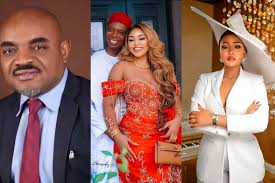
Ex-President Obasanjo, as we can see, used the People’s Democratic Party (PDP) to rule Nigeria for eight years. As soon as he assumed office in 1999, he made up his mind to reduce Nigeria to a one-party state, his pet party system which he canvassed vigorously while Nigeria conducted its transition to civil rule programmes. The first part of this serial chronicled how he shrivelled the opposition parties and made the PDP into a colossus that dominated the political landscape. Eventually, most leading lights in the opposition parties decamped to the PDP.
By 2007 when Obasanjo was constitutionally forced out of power, PDP was at the zenith of its power and glory. It had 26 out of the 36 governors, 260 out of the 369 members of the House of Representatives, 85 out of the 109 senators and an emphatic command of the majority in the state legislatures and the 774 local councils. It was at this point that the party started priding itself as “the largest party in in Africa”, and some of its chieftains boasted that the PDP would rule Nigeria for “sixty years”.
The size of the Party was largely as a result of Obasanjo’s repression of the opposition parties, which became unattractive for politicians tocontest for power. The party was so powerful that Obasanjo suddenly developed an ambition to grab extra terms of office for himself when he was nearing the end of his constitutional two terms. To succeed, he nullified the membership of the party and ensured that all party members were re-registered. This, of course, ensured that those Obasanjo did not want in the party were weeded. These included former Vice President Atiku Abubakar and former Governor of Abia State, Chief Orji Kalu.
When his tenure elongation plans failed, Obasanjo put his Plan “B” into effect. He opted to unilaterally install his successor in office. He chose a terminally ailing Governor Umaru Yar’ Adua of Katsina state for president and paired him with a quiet, self-effacing Governor of Bayelsa State, Dr. Goodluck Jonathan as Vice President. He also planted his cronies as governors of the various states. He even planted them in opposition parties.
A case in point was in Imo, where the Obasanjo ordered the PDP to withdraw from the governorship race and support Chief Ikedi Ohakim, who had decamped from PDP when he failed to get the ticket at the primaries and ran on the ticket of the Progressive People’s Alliance (PPA).
Obasanjo’s ambition, at this juncture, was to become the Life Leader of the PDP, such that he could wield great political influence and lord it over the occupants of Aso Villa from Ota or Abeokuta.
The plan ran into storms, however. When Yar’ Adua assumed power, he refused to dance to Obasanjo’s tunes. He was determined to leave a legacy of his own. Obasanjo was not given any space to maneouvre. But unfortunately, Yar’ Adua became seriously sick and died in 2010. Obasanjo jumped out of his political doghouse and started prompting Jonathan to run on his own terms in 2011, even though many northern leaders preferred that he allowed one of theirs to replace him.
Soon, Obasanjo found out he had lost his place in the PDP even under Jonathan. It was so bad he was almost ignominiously booted out of his Board of Trustees Chairman post. In the middle of 2013, he resigned from the post. President Jonathan was later on to describe Obasanjo as “a goat seller who, after selling his goat, refuses to release the rope”. The Ota-born chicken farmer went home and started the war that led, ultimately, to the end of PDP’s reign.
In January 2014, he published one of his series of scandalous open letters to President Jonathan, accusing him of every abominable sin under the sun, including training snipers to kill his political opponents. A man under whose watch many prominent people were murdered was accusing a president who never recorded a single such incident in his five and half years as President!
Between April and May 2014, Obasanjo went round many states of the North and persuaded some of the governors he planted in power to run for president to replace Jonathan. Some of these were: Governors Sule Lamido of Jigawa, Rabiu Kwankwaso of Kano, Magatakarda Wamakko of Sokoto and Babangida Aliyu of Niger. Some of these OBJ-made governors were at the forefront of the rebellion against Jonathan.
The tipping point came when five of the rebel governors decamped from PDP and joined the newly amalgamated All Progressives Congress (APC) which was put together by Asiwaju Bola Ahmed Tinubu and General Muhammadu Buhari.
From that point on, the rapid emaciation of the PDP could no longer be stopped. Obasanjo was relentless in his attacks on Jonathan. Apart from writing public letters, he also nudged some of his out-of-work former ministers, such as Oby Ezekwesili, Nasir el Rufai and lately, Charles Soludo, to slam the Jonathan administration each time they got the chance to go public. Obasanjo climaxed his choreography with the public tearing of his PDP membership card a couple of months to the presidential election.
Of course, PDP’s fall from power under the watch of President Jonathan was further helped by the President’s failure to take decisive steps when and where he needed to. This made him subject to blackmail. Jonathan surrounded himself with people who posed as his lovers but were actually deceivers. They took whatever they could from him and abandoned him when he needed them most. Matters were not helped by his sloppy handling of the Boko Haram insurgency, which grew from a small pox on the nose to a plague that wracked the whole nation.
Perhaps, if Jonathan had been a little more in charge and decisive, he would have prevented some of the little problems that ballooned to decide for him only one term in office. But Obasanjo was the headwind that chipped away, unchallenged, at the pedestal of his presidential power.




















